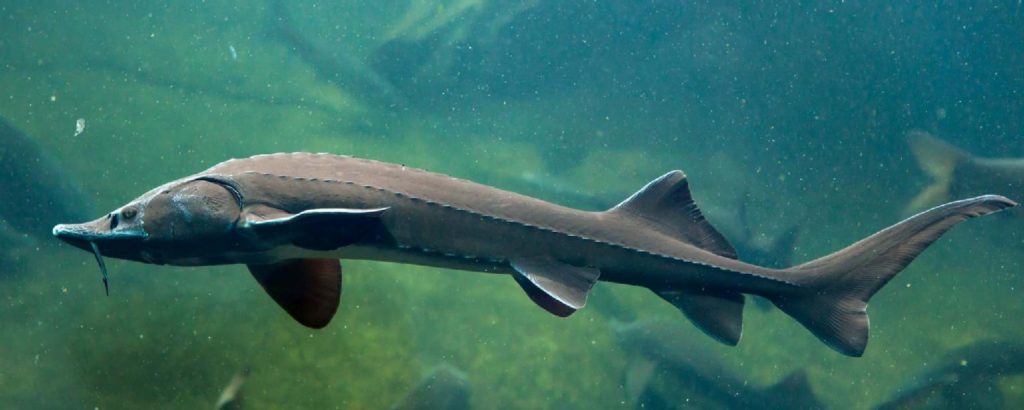Get Your Fresh Sturgeon News Only at LGM!

Only LGM provides you with the sturgeon news you demand! And for once, it’s actually kind of good news.
Lake Winnebago is one of only two locations in the world where people can spearfish lake sturgeon. These armored fish, also distinguished by whiskerlike barbels growing from their chins, can live as long as a century, weigh as much as 200 pounds, and grow more than seven feet long. Every year, people gather on the lake for a 16-day fishing event. Just 500 licenses exist, a number that keeps overfishing in check while allowing nearly 1,000 sturgeon to be taken for their caviar (for those lucky enough to catch a female) and meat (delicious when smoked).
The sturgeon spearing event will mark its 80th season this year. And with the fish listed as threatened in 19 of the 20 states where it’s found, Wisconsin wildlife officials consider the event one of a number of tactics that help educate people about the fish. (Another is an adoption program allowing members of the public to sponsor and hand-release young fish, reared at a state hatchery, into Lake Michigan and the Milwaukee River, part of the annual SturgeonFest.) Efforts to revive their populations have been somewhat successful, but it’s been slow going: Female lake sturgeon don’t start reproducing until they’re at least 20 years old.
This biological fact, combined with overfishing, pollution, and habitat degradation, has resulted in their plight today. An estimated 15 million sturgeon used to exist in the Great Lakes, with fishers bringing in upwards of four million pounds per year between 1879 and 1900. The trade took a serious toll on the species. By 1929, commercial sturgeon fishing had closed in Lake Michigan due to too few fish. And by the end of the century, fishers had taken 80 percent of the sturgeon out of Lake Erie. Meanwhile, dams and development ruined habitat and kept the fish from reaching key spawning grounds. In response to the population crash, most states instituted protections and mandated hunting limits in the 1990s and early 2000s
Today, only 1 percent of the lake sturgeon’s population remains. In addition to the states that list them as threatened, the United States Fish and Wildlife Service announced in August that it would study whether to list the fish as federally threatened or endangered.
OK, things aren’t great. But….
Ryan Koenigs, a fisheries biologist with the Wisconsin Department of Natural Resources (DNR), is among those dedicated to bringing the lake sturgeon back. He’s part of a team that keeps track of every individual caught, and he helps run the registration stations where fishers who spear a sturgeon in Lake Winnebago must go before taking their catch home. Koenigs and his colleagues look for a passive integrated transponder (PIT) tag, which offers information about the fish. These tags are implanted in each fish reared or caught and released by the agency. Some individuals caught in the past few years were tagged decades ago. “I’m reaping the benefits right now of what the biologists two generations before me did in the 1970s,” Koenigs says.
Restoration efforts also exist in many other states bordering the Great Lakes. In New York, the Department of Environmental Conservation, the U.S. Fish and Wildlife Service, and the Saint Regis Mohawk Tribe harvest sturgeon eggs from the St. Lawrence River and send them to hatcheries in the central part of the state and in Wisconsin. In Michigan, fisheries biologists, researchers, and state agencies successfully protected the sturgeon population in Black Lake and now use the data collected from their efforts to guide their restocking of nearby lakes and streams.
These types of projects replenish waterways with the fish, but the species’ recovery has a long way to go. Should conservationists succeed, the fish could end up benefiting the entire ecosystem, notes Ed Baker, a fisheries biologist in Michigan. “If we have a native species fish community that’s been degraded, that’s a sign that its environment is no longer healthy,” he says. “If we can restore lake sturgeon to their prominence, or at least somewhat close to what their prominence was before we started harvesting them, that’s a sign that we’re doing the right thing for the Great Lakes.”
As the lake sturgeon populations rebound, they could help biologists beat back some new threats, too. Notably, they eat invasive zebra and quagga mussels that now blanket the lake beds. They also eat invasive round gobies. All three of these marine species hail from faraway waters and snuck their way in through the ballast water used to balance ships’ hulls.
An animal like sturgeon is hard to bring back, since it is basically a swimming dinosaur. There are real challenges. But it’s also important to highlight the conservation work that is going on and fight for a government that will prioritize this and other environmental issues going forward.


